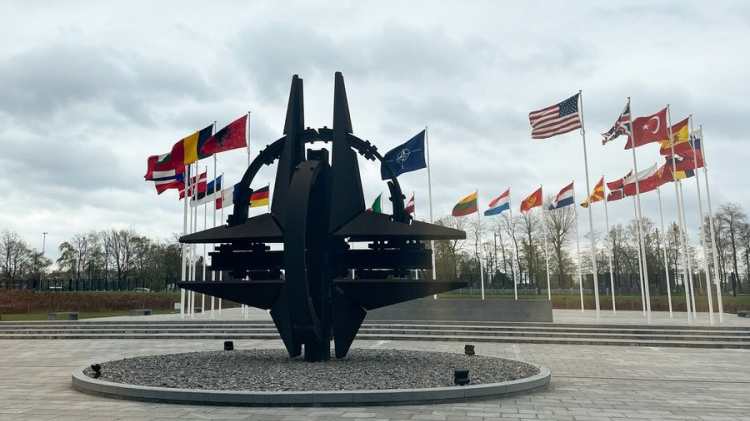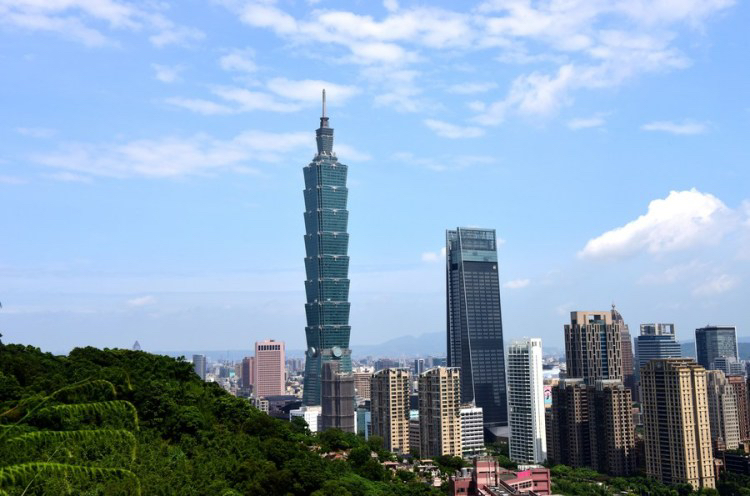
A sculpture and flags at NATO headquarters in Brussels, Belgium, April 6, 2022. /Xinhua
A sculpture and flags at NATO headquarters in Brussels, Belgium, April 6, 2022. /Xinhua
Editor's note: Azhar Azam works in a private organization as "Market & Business Analyst" and writes on geopolitical issues and regional conflicts. The article reflects the author's opinions and not necessarily the views of CGTN.
Asia-Pacific is the U.S.'s "priority theatre of operations" and lies at the heart of America's grand strategy to pursue global hegemony. The U.S. Defense Secretary Lloyd Austin last year outlined the region as "center of strategic gravity" to gang up regional states against China, while trying to claim Washington wasn't splitting the region into hostile blocs.
The Joe Biden administration still contends it doesn't want competition with China to veer into a conflict; the U.S. officials continue to accuse China of taking aggressive actions and tempting Asia-Pacific countries with a delusive "gravitational pull of freedom." Within this grand strategy, the U.S. intelligence community alleges China of dominating the region, driving wedges between America and its partners and extending Chinese influence, particularly in East Asia and the western Pacific while itself conducting military exercises around the sensitive regional waterways.
An explicit intent is to rally allies under the pretense of deterrence and protection against China, contain Beijing's rise and reinstate the U.S. role as the world’s sole superpower. Japan's major shift from a pacifist nation to a menacing force, signaling the biggest military posture since the World War II, is welcomed and praised because the unprecedented increase will boost arms production and profit the U.S. military-industrial complex.
Contrarily, China's defense spending at $224 billion is dwarfed by the U.S. Department of Defense budget of more than $1.7 trillion for the fiscal year 2023, which is needed to execute aggressive military plans and operations. In addition, America is a consistent threat to the region's peace and stability as it has the largest aviation force in Asia-Pacific with more than half of its fighter planes comprising fourth or fifth generation models.
Former U.S. Secretary of State Mike Pompeo last year suggested America must make "three lighthouses of liberty" (Israel, China's Taiwan region and Ukraine) the hubs of new security architecture in the Middle East, East Asia and Europe and link these bastions with NATO and the new and expanded security framework of Asia-Pacific to form a "global alliance for freedom."
His concept may have not been officially endorsed by the Biden administration; but it has increased Europe's security dependence on the U.S., pitted the Mideast countries against each other and is trying to take advantage of the Ukraine crisis to mend its frayed relations with its partners in Asia-Pacific. Washington is doing so by stoking tensions and increasing arms sales to regional states as well as reinvigorating the four-nation Quad and the trilateral AUKUS alliances not just to encircle China but to impose its leadership on the region.

Photo taken from Xiangshan Mountain shows the Taipei 101 skyscraper in Taipei, southeast China's Taiwan, July 21, 2019. /Xinhua
Photo taken from Xiangshan Mountain shows the Taipei 101 skyscraper in Taipei, southeast China's Taiwan, July 21, 2019. /Xinhua
Yet the strategy is backfiring. China's emergence as a peace-broker between Saudi Arabia and Iran is shattering America's great plan; the U.S. efforts to use the Ukraine conflict as a conduit to restore its global hegemony is challenged by some wealthy, powerful and democratic U.S. allies that have maintained their autonomy.
Given regional organizations such as Association of Southeast Asian Nations (ASEAN) and the African Union are focused on regional development rather than catching "fever" of the U.S. fixation with China, other Asia-Pacific states will be cautious of aligning too closely with Washington and may pursue an independent foreign policy.
The framing of competition with China by Republican Mike Gallagher, chairman of the House China Task Force, as an "existential struggle" is both misguided and risky. The committee "forged out of paranoia (and) hysteria" which tends to get locked into groupthink and xenophobic mindset as the U.S. "actively" seeks to contain China and derail its technological progress. This approach will inevitably escalate tensions between China and the U.S. and make engagement even more difficult.
Communication channels between the two militaries froze after China-U.S. relations ebbed over America's hyperboles on the balloon saga. The U.S. defense officials dubbed the lack of communication as "destabilizing and dangerous" yet by calling off the U.S. Secretary of State Antony Blinken's trip to China, shooting down a Chinese object with a missile, planting NATO clones such as the Quad and the AUKUS in Asia-Pacific, the U.S. has exposed its petty-minded approach to circumscribe China and its inclination to shutter communication channels.
The Biden administration has clearly set out its ambition, which is to implement the 2022 National Defense Strategy to tackle the "pacing challenge" from China. As part of this strategy, a U.S.-led systematic campaign is underway to attribute false threats to China with claims of Southeast Asian states likely to become "wearier participants" in the Belt and Road Initiative (BRI).
But there's a catch: the U.S. Indo-Pacific Economic Framework, the means to advance the U.S. Indo-Pacific Strategy, is more of a showpiece for it actually delivers very little to the region, especially to ASEAN. In contrast, Chinese infrastructure and development projects such as the BRI and the Global Development Initiative are lionized by regional states, indicating Asia-Pacific doesn't want to become an avenue of a great power competition.
At the first anniversary of the Indo-Pacific Strategy, the Biden administration's primary focus remains the Quad and the AUKUS, both of which take frequent mentions in the latest State Department's report. But in Southeast Asia, nations have never greeted the military alliances with skepticism. They have criticized AUKUS for its propensity to trigger arms races in the region and remained concerned about these anti-peace and provocative security partnerships. As a result, the U.S. grand strategy is condemned to failure.
(If you want to contribute and have specific expertise, please contact us at opinions@cgtn.com. Follow @thouse_opinions on Twitter to discover the latest commentaries in the CGTN Opinion Section.)